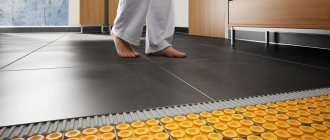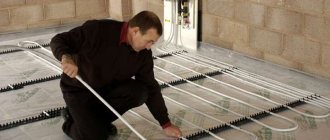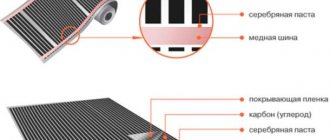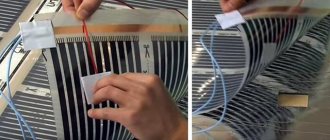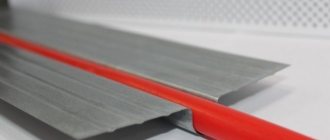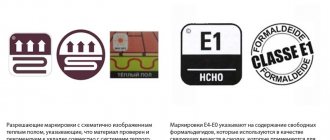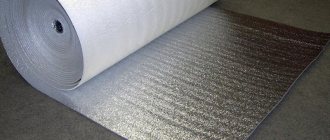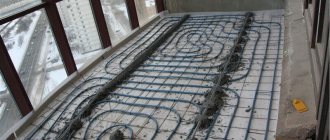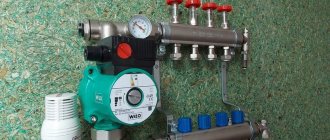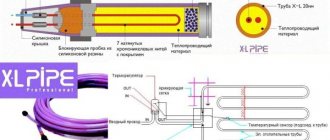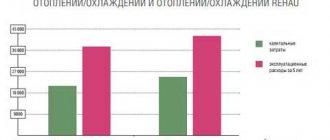Home » Equipment » Warm floor
Standard screed floors with insulation are more difficult to install, and they also narrow the space due to their height. A heating mat for underfloor heating is an alternative solution to these problems. People are often demanding of environmental conditions.
These conditions are different for everyone, but they fluctuate in the same temperature ranges - around 20-23 degrees at floor level and from 23 to 27 degrees at height level is enough to satisfy the requirements of any person. But no battery can create such temperature parameters.
To create an optimal microclimate, mats for heated floors with bosses were created. Due to the fact that the wire underlying the heating plates does not interact with the environment, they do not displace moisture and do not raise dust microparticles into the air.
Heated floor mats have their positive sides
A heating mat for a warm floor is practically a standard insulated floor, with the difference that it is installed in tile adhesive. It is not demanding to install and can be installed with your own hands without any problems.
It is also worth noting that heating plates increase the height of floor coverings only to the level of the adhesive and tile layers.
These devices are a system of electrical wires that are placed on plates. They operate by connecting to a standard network; the temperature regulator sets the desired mode, power, room temperature control and heating time. Such heating equipment is appropriate if:
- the dimensions of the room will allow you to lay an additional layer;
- you already have additional decorative coating;
- you have a different heating system installed.
We recommend: What are the characteristics of Aura underfloor heating?
You can order various types of heated mats from official suppliers. The difference is present both in price and in the guarantee that they will serve their full service life. The most prominent are 5 types of heating systems:
- two-layer ProfiMat heating plates. Universal models will, without exaggeration, last a lifetime, thanks to a special assembly system. The permissible laying area is up to 15 square meters. They are installed both on top of old floors during renovation and in new ones, and are combined with all possible coatings;
- Tropix thermomats. Less demanding mats with built-in cables. They guarantee environmental friendliness and will last up to 50 years, suitable for installation in rooms up to 14 square meters;
- mats called “National Comfort”2NK. Equipped with a thermoplastic screen and a two-layer heating cable. Thermoplastic provides protection against mechanical and electrical damage. Capable of heating rooms up to 12 square meters. Warranty period up to 25 years;
- standard WSM mats. The heating cable is fixed on a glass mesh and mounted in a thin layer of glue. Operational life 25 years;
- super-thin Alumia mats. Due to the increased level of reliability, they are most often used in rooms with children. A thickness of 1.5-1.6 mm allows you to install thermomats under particularly thin coatings, such as linoleum, laminate, parquet and others. Easy installation with a 15 year warranty.
Sometimes making a choice can be difficult. People are picky about serious matters, especially if they concern high price tags, the quality of the product provided, and durability.
If any question arises, consultants on manufacturers' websites, in Moscow offices and companies in neighboring regions will solve your problem.
Features of operation
To ensure the safe and effective use of heating mats, it is recommended to take into account some operational points:
- Do not connect the floor heating system until the adhesive base has completely hardened;
- to avoid overheating of the heating device when the temperature reaches 70 degrees, immediate shutdown of the equipment is required;
- It is not recommended to place furniture or other interior items in areas where heating mats pass;
- when laying the system, it is prohibited to overlap heating areas;
- the use of thermomats in rooms with high humidity levels requires the mandatory installation of an RCD.
When installing heating mats, you must take into account all the recommendations listed by the manufacturer in the attached instructions.
Proper installation and connection of the heating device will allow you to maintain a comfortable temperature in the room for many years. Therefore, it is recommended to entrust the entire equipment installation process to specialists.
Laying heated floor mats. How to install?
Laying heated floor mats occurs with the snap of your fingers. No calculations or manual cable connection. The product is equipped with everything necessary and is initially ready for installation. The best solution for additional heating of rooms.
We recommend: What is the pipe consumption for underfloor heating per m2?
Basically, parts of the mats are attached to a glass mesh or aluminum foil, then there is nothing complicated in installation. But if you decide to do the repairs yourself, then you need to adhere to a set of rules:
- the size of the mat is calculated without taking into account areas with household appliances and furniture;
- per room there is one thermomat that heats the surface;
- mats with a thin cable are installed in the adhesive under the tiles;
- Each mat is controlled by a temperature controller.
Design and principle of operation
The design of the heating mat consists of a cable fixed in a mesh made of fiberglass. The thickness of one mat is no more than 3 millimeters, and the standard width of the reinforced base is 50 centimeters.
When laying, the mats can be cut into the required strips, which simplifies their installation and allows for convenient placement of any floor surface.
The principle of operation of the mats is completely simple. The device is connected to the electrical network. The current passes through the wires that make up the inside of the cable. As a result, the floor covering heats up.
Mats for water insulated floors
Products for water-heated floors have low thermal conductivity and are necessary to ensure that heat is distributed evenly throughout the room.
The most accessible and inexpensive option for concrete floors is polystyrene foam, or in common use polystyrene foam, which holds the load well and prevents heat loss. It also has special cells, thanks to which you can easily connect sheets together.
Expanded polystyrene is divided into types:
- polyethylene mats with a foil layer on top. Thanks to the coating on both sides, the heat flow is evenly distributed over the entire area of the room. It is recommended to install in already heated rooms, where initially another insulation will be laid under the heated floor. In order for the canvas to fit tightly, it is necessary to secure it with additional elements: clamps, staples, etc. To seal, the sheets are placed end-to-end, gluing with foil tape;
- foil mats based on polystyrene. The best combination of frost resistance, sound insulation, moisture resistance. Among competitors, it has lower thermal conductivity and can withstand sudden temperature changes. Due to its high quality, ease of installation and thickness, it is the most expensive of the substrate materials;
- extruded polystyrene foam mats. The products come with both bosses and smooth ones, resembling mats 2-5 centimeters thick. Lugs make it easier to lay the heating cable. They are resistant to overheating and temperature fluctuations, and have good mechanical properties. More accessible and inexpensive material.
We recommend: What characteristics does Caleo underfloor heating have?
Each option is good in its own way, but it is better to invest in the long term, not to save, but to choose a better option that will last for decades without failure.
Expanded polystyrene mat
Flooring
If the heated floor was made under tiles, then take a special tile adhesive for heated floors and lay it directly on the mats (you can additionally put a reinforcing mesh - the cables will be more intact). You just need to remember that the thickness of the glue + tile should be more than 2cm. You can turn on the floor only after the glue has completely dried (each composition has its own time, indicated on the package).
All floor coverings except tiles require a screed
To lay all other coverings, a screed is required. Its thickness is 2-3cm. The composition is also for heated floors. Having leveled the layer, leave it to dry. Then you lay laminate, carpet or parquet. Read about choosing a finishing coating for a heated floor here.
Not the most difficult installation. What is upsetting is the need to wait until the tiles and screed “settle.” In any case, it will be possible to turn on the warm electric floor only after the glue or solution has dried. And you cannot use heating to speed up the process. This can damage the heated floor or lead to the formation of cracks, which will impair heat transfer.
Let's figure out how to install heated floors on mats
The models of mats are different, but they have similar components installed. They consist of:
- steel or copper electrical cable;
- wires housed in a protective sheath made of polymer or fiberglass;
- meshes made of non-metallic alloys;
- aluminum film;
- polyvinyl chloride shell, protecting from external influences;
- The width of the mats varies from 1 to 43 meters (individual sizes are selected for each room).
Types of thermomats
Twin-core heating plate
There are several varieties of counterfeit materials, and when purchasing, you need to know exactly which one is suitable for a particular room. If you are faced with a choice of which heating equipment to purchase - single-core or double-core, you first need to study the characteristics of each:
- single-core heating plates. In this category of substrate materials, the wires consist of a single core. The base can be metals: brass, galvanized, nichrome and others. It is due to them that resistance occurs with subsequent heating. During operation, an electromagnetic field appears, which is partially neutralized by the protective aluminum film. Used outdoors or in industrial buildings;
- twin-core heating plates. Thanks to two conductors, the heating power is higher than conventional ones. Increased power consumption due to two cables, but easier installation. The electromagnetic field is dampened by wires, radiation is minimized. Suitable for bathrooms and living rooms.
Thermomats are an excellent analogue of classic floor insulation and are ideal for water-based coatings. Installing this type of heating is a good solution that combines quality and durability. And even a person with no experience can figure out the installation.
- Related Posts
- How to lay heated floors on planks?
- How to install a heated floor sensor?
- How to install underfloor heating on a wooden floor?
- How to make a dry heated floor?
- How to install a water heated floor with your own hands?
- How much does a heated floor consume?
Comments:
Carlson
Great review! Self-regulating cables are still really blatant “G”, which is not suitable for heated floors, especially in the form of mats. I have never come across any worthy offers in this segment - it’s all just China.
Paul
I do not recommend such mats to my clients. Maybe such designs help beginners; I find it much more convenient to attach the cable directly to the floor, and you can bend it in any direction.
Larion
Pavel, I agree. In any case, reinforced mesh + cable + fastenings will cost less than the assembled mat.
Andrey
Maybe it's time to indicate prices in rubles! We live in Russia after all!
Leave a comment Cancel reply
Related Posts
Features, disadvantages and advantages of cable heated floors.
Thermo underfloor heating – Swedish quality under your feet.
What a Heat Plus heated floor can and cannot do. Advantages and disadvantages
The underfloor heating regulator is an important part of the entire system.
